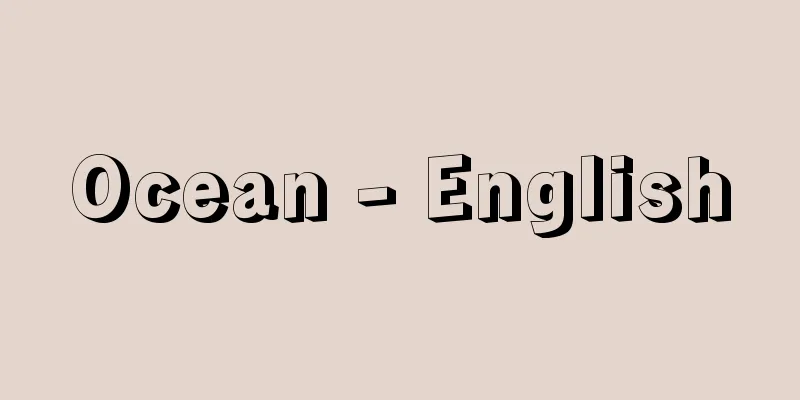Ocean - English

Marine NatureIt refers to a very large expanse of water that contains salt (salts). This water is called seawater. The composition ratio of salt is almost the same everywhere in the ocean. Some large salt (water) lakes are called seas. These are the Caspian Sea, the Aral Sea, and the Dead Sea. However, the ratio of the amounts of elements dissolved in the water of salt lakes is completely different from that of seawater. The ocean is not just a large pool of water, but the crust underneath (oceanic crust) is completely different from the crust underneath the continents (continental crust). The oceanic crust is 5 to 15 kilometers thick, is basaltic, and the oldest part was formed 200 million years ago. The continental crust is 20 to 65 kilometers thick, the upper part is granitic, and the oldest part is 3.8 billion years old. The Caspian Sea is a lake, but the central part is under oceanic crust. [Masao Hanzawa and Kenzo Takano] Ocean GeographyThe oceans cover 361.06 million square kilometers, or 70.8%, of the Earth's total surface area of 509.95 million square kilometers. Land accounts for a larger proportion of the land in the Northern Hemisphere, while ocean accounts for a larger proportion in the Southern Hemisphere. Although the oceans are continuous, they can be divided into several parts. The largest part is the ocean, which includes the Pacific, Atlantic, and Indian Oceans. Seas that are connected to oceans via islands or peninsulas are called marginal seas, and the Mediterranean Sea is a sea that is surrounded by several continents but is connected to the ocean. The oceans are not only deep basins filled with seawater, but the margins of the continents are extensive continental shelves. A hypsographic curve is a graph that plots the area of the oceans and land by height and depth based on sea level. According to this curve, the area of the land up to 1000 meters above sea level and the area of the ocean up to 5000 meters below sea level occupy a particularly large area. The average height above sea level of the land is about 840 meters, while the average depth of the entire ocean is about 3800 meters. Since the area of the ocean is 2.4 times that of the land, the volume of the ocean is more than 10 times that of the land. The average depth of 3800 meters is only 1/1700 of the radius of the Earth (about 6400 kilometers). The oceans and the atmosphere are characterized by being "thin and wide." This characteristic has a great influence on the movement of seawater and the atmosphere, as well as the temperature distribution. [Masao Hanzawa and Kenzo Takano] Properties of seawaterThe salinity of seawater is defined as the ratio of the mass of substances dissolved in seawater to the mass of seawater, and is expressed in parts per thousand. In everyday terms, salinity is saltiness, or the amount of salt, but salinity here is the chemical term salt or the concentration of salts, so we say high salinity or low salinity. We do not say that it is highly saline or has a high salt concentration. Seawater contains various salts, such as sodium chloride, magnesium chloride, magnesium sulfate, and calcium sulfate. Although the salinity varies depending on the location, seawater is characterized by the fact that the composition ratio of salts (or the ratio of element amounts) is almost constant everywhere. Except for some areas such as near river mouths and the Red Sea, the salinity is 34 to 37‰. Towards the end of the 20th century, salinity was defined by the electrical conductivity of seawater, separate from the salt concentration. A salinity of 35 according to this definition (practical salinity) is equivalent to the old definition of 35‰ (absolute salinity). To indicate that this is a practical salinity, it is often written as 35 psu (psu is an abbreviation for practical salinity unit). For salinities other than 35, the difference from absolute salinity (1000 times) is very small. Seawater is 96% water (by weight), so its physical and chemical properties are similar to those of water. Although water seems like an ordinary liquid, it is in fact a unique liquid, along with mercury and liquid ammonia. Its specific heat, heat of vaporization, heat of fusion, thermal conductivity, and surface tension are extremely large, while its thermal expansion coefficient and compressibility are extremely small. Seawater's density is determined by temperature, pressure, and salinity. Because its specific heat is large, the change in temperature is small, but because its thermal expansion coefficient is small, the change in volume accompanying a change in temperature, and therefore the change in density, is also small. Furthermore, because its compressibility is small, the change in volume and density accompanying a change in pressure are also small. Because the change in density is small, the change in pressure is also small. Because the change in pressure is small, the geostrophic current, which is determined by the pressure difference, is weak. This is the main reason why the current of seawater is much weaker than the current of the atmosphere (wind). Seawater is a liquid that does not evaporate easily because its saturated vapor pressure is much smaller than that of other liquids, and its volume does not change significantly in a short period of time. Although the amount of water evaporating from the ocean's surface is small, the heat of vaporization (also called latent heat) is the largest of all substances, so the heat of vaporization that escapes from the ocean into the atmosphere as it evaporates is large. This heat of vaporization is an important source of energy for the atmosphere. Fresh water has its greatest density at 3.98°C, but the density of seawater with a salinity higher than 24.7 psu increases as the temperature drops. Salt lowers the freezing point of seawater to around -2°C. Excluding underground, just under 99% of fresh water on Earth is frozen, but due to the effects of salt and the extremely high heat of fusion of seawater, only just under 0.004% is frozen. Most liquids become heavy when frozen and sink, but water becomes lighter when frozen and floats on the surface. Sea ice is a good insulator because it has low thermal conductivity and high specific heat. Because it is a good insulator floating on the sea surface, the seawater beneath the ice does not cool easily. The refractive index of light is quite small, and the radiative reflectance of the ocean surface is small. The radiative reflectance varies depending on the altitude of the sun, the waves on the ocean surface, the amount of seawater pollution, and the amount of phytoplankton, but it is much smaller than the radiative reflectance of land, making it easier for the ocean to absorb solar radiant energy that reaches the Earth. Both the oceans and the atmosphere are fluids that spread across the Earth, but due to the unique properties of seawater, the oceans are a much more stable fluid that is less likely to change than the atmosphere, and this is reflected in the atmosphere, keeping the atmosphere and the Earth's environment relatively stable - not changing significantly over short periods of time. Water has the highest thermal conductivity of all liquids except for mercury, and is very good at transmitting heat. This thermal conductivity is the molecular thermal conductivity when heat is transmitted by molecular motion. In the ocean, eddy conduction (diffusion) works, and eddy conduction is much stronger than molecular conduction, so a large molecular thermal conductivity is not important. Water is an excellent solvent, so many different substances are dissolved in seawater. This means that the osmotic pressure is high, reaching 24-25 atmospheres compared to freshwater. This has important implications for marine life. There are several things that suggest that life first appeared in the sea, one of which is that water is the most abundant (by mass) of all the substances that make up living organisms. Also, seawater and human serum have similar ratios of components. Compared to seawater, serum has less magnesium and sulfate and more bicarbonate, which seems to be an adaptation to an environment where breathing is required through lungs. [Masao Hanzawa and Kenzo Takano] Oceans, Weather and ClimateThe physical properties of the atmosphere (air), ocean (seawater), and land (soil, rocks, etc.), especially heat capacity and specific heat, are very different. For the same volume, the heat capacity of ocean water is much greater than that of air. Therefore, the ocean, which occupies most of the Earth's surface, has a huge impact on the weather. Small-scale effects include land and sea breezes. Medium- to large-scale weather phenomena include heavy snowfall on the Sea of Japan coast and cool summers in Tohoku and Hokkaido. Very large-scale effects include the deviation of the position of the jet stream due to the influence of positive or negative sea surface temperature deviations at 25-45 degrees north latitude and 150-180 degrees west longitude in the central North Pacific Ocean, and the resulting abnormal weather in North America, as well as the so-called seesaw phenomenon in which the water temperature on the American side and the Japanese side of the North Pacific Ocean is high on one side and low on the other side at almost the same time. The El Niño phenomenon in the equatorial Pacific Ocean is also a large-scale phenomenon involving the ocean and the atmosphere. Such phenomena in which factors such as water temperature and air pressure change at almost the same time over long distances are called meteorological and oceanographic teleconnections. [Masao Hanzawa and Kenzo Takano] Ocean and LifeThere is much debate about the origin of living organisms, or "life," but it is believed that the first was a single-celled primitive plant or algae that arose in the ancient ocean. Unmetamorphosed sedimentary rocks discovered in the Barberton Mountains in northeastern South Africa are thought to be 3.3 billion years old and contain tiny carbon particles that could be the origin of life. South African limestone of the same age contains stromatolite-like structures that are attributed to green algae. There are various theories about the amount of oxygen necessary for the survival of living organisms. According to one leading theory, at the end of the Precambrian period (about 600 million years ago), there was almost no free oxygen in the atmosphere, and animals lived in "oxygen oases" called algae, which they used as hosts and relied on for breathing. In the early Paleozoic era, oxygen pressure increased, and animals began to leave their hosts and float to the boundary between the atmosphere and the ocean. As time passed and the amount of oxygen in both the atmosphere and the ocean became more abundant, living organisms began to distribute widely on land and in the sea. In 1953, American chemist Stanley Lloyd Miller (1930-2007) conducted a groundbreaking experiment in which he circulated a mixture of methane, ammonia, hydrogen, and water vapor through water and used corona discharge to produce several amino acids, hydroxylic acids, and other organic compounds. In addition, progress has been made in elucidating the formation and evolution of other planets and their atmospheres. The composition of the Earth's atmosphere and seawater at the time of the emergence of life has been revealed, and it seems likely that the day is approaching when the origin of life will be confirmed. [Masao Hanzawa and Kenzo Takano] Ocean ExplorationArtifacts from the trade of the ancient Mediterranean civilizations, such as the Phoenicians, Egyptians, and Romans, show that they had some knowledge of ocean currents, tides, and wind systems, and eventually crossed the "Pillars of Hercules" (the Straits of Gibraltar) into the Atlantic Ocean. From the 15th century onwards, there were a succession of great voyages to acquire colonies, but what characterises voyages from the 18th century onwards is that a new purpose, academic research, was added. From the long 19th century onwards, oceanography began to be systematised as an academic discipline. After World War II, there was a major change in research methods and methods. As research results accumulated, the era moved from "exploration" to "experimentation". From the end of the 20th century, marine research related to the global environment and climate became active. [Masao Hanzawa and Kenzo Takano] History of Ocean ExplorationIn ancient Greece, maps from the time of Homer around 1000 BC and maps from Hecataeus around 500 BC showed the world at its center, with the Mediterranean Sea surrounding it, surrounded by oceanic rivers. A map by K. Ptolemy around 150 AD shows parts of the Atlantic Ocean and the Indian Ocean, indicating the expansion of geographical knowledge. A notable event from this period was the voyage of the Greek Pytheas (356-323 BC). In 325 BC, Pytheas left the Strait of Gibraltar, sailed around the coasts of France and Britain, and reached Thule (Iceland or Norway). He recorded seeing a "slow-flowing, congealed or frozen sea" near Thule. It is not known whether this was a swarm of jellyfish, a gelatinous mass of diatoms, or sea ice, but in any case, it was a groundbreaking record of observations of the sea. Pytheas was the first to point out the relationship between the ebb and flow of the tides and the movement of the moon, and it was Poseidonius who considered the relationship not only with the moon but also with the sun. The Middle Ages was a time when Europe learned science and technology from China and Arabia (Islamic nations), which were the most advanced countries at the time. As early as the 9th century, it was stated that ocean currents change direction with the changes in the trade winds of the Indian Ocean. The 12th century was a time of great translations, when many Greek and Arabic documents were translated into Latin. The Crusades (1096-1270) contributed greatly not only to the import of science and technology, but also to the exchange of these between Western and Northern Europe. As a result, ship structure, shipbuilding, and navigation techniques were improved, ushering in the Age of Discovery. The status of sailors in society also changed. The sea was associated with monsters, hunger, cold, sin, and evil spirits, and sailors were often associated with "violence" and "ruffians." However, from the 13th century onwards, kings of England and France became interested in the sea, and knights began to sail on ships, and sailors sometimes became knights. Naval knighthoods were also formed. Sailing and sailors came to be associated with aggressiveness, challenges to the outside world, and development. The spread of compasses, introduced from China, improved the safety of sea voyages and prompted the improvement of nautical charts. The Mercator projection, the most convenient method for navigation, was invented by Dutch mathematician Mercator in 1569. In the second half of the 16th century, devices were used to measure ship speed. Knowing a ship's position is essential for navigation. It was already known in Phoenicia that measuring the altitude of a celestial body could be used to find the latitude of a given point. Tools for measuring altitude were improved, moving from the quadrant in the time of Columbus (pronounced Colombo in Italian as Christoforo Colombo) to the octant, and then to the sextant in the mid-18th century. To know the longitude of a point or the difference in longitude between two points, a clock that works accurately even on a rocking ship is necessary. Around 1600, King Philip III of Spain and the Dutch National Assembly each offered a large prize for the invention of a marine clock. Galileo and Huygens also tried, but both failed. A little over 100 years later, in 1714, the British government offered a prize again, followed by the French government in 1716. John Harrison of England won the British prize in 1765, and Pierre Le Roy (1717-1785) of France won the French prize in 1773. By the end of the 18th century, it had become possible to measure longitude on the open sea with a reasonable degree of accuracy (100-150 kilometers). The motivations for the great voyages were trade and the acquisition of colonies. Pytheas's voyage was to prevent the Phoenician monopoly, the Portuguese voyage to the East (India, China) via the Cape of Good Hope was to develop a new sea route that was not under Arabian control, Columbus's voyage was to reach China and India by going west around the southern North Atlantic, and the voyage of the Caboto father and son (Giovanni Caboto 1450-1498, Sebastiano Caboto 1476-1557, pronounced Cabot in English) was to reach China and India via the northern North Atlantic (it was not known at the time that this sea route did not exist). After Spain and Portugal discovered the New World and opened sea routes to India, solidifying their status as maritime nations in the Age of Discovery, England and the Netherlands, which were somewhat late to the game, focused on the northern seas, where Spain and Portugal did not have strong interests. It was already known in the 15th century that the shortcut to the Far East was via the Arctic Ocean. At the end of the 16th century, the Netherlands offered a reward for the discovery of the Northeast Passage (a route that travels northeast from the North Atlantic, travels east across the Arctic Ocean, and exits the Bering Strait into the Pacific Ocean). At the beginning of the 17th century, England established the "London Merchants' Guild for the Exploration of the Northwest Passage (a route that travels northwest from the North Atlantic, travels west across the Arctic Ocean, and exits the Bering Strait into the Pacific Ocean)" and sent out an expedition, but it was unsuccessful. In 17th century Europe, the price of spices had fallen, but the commercial value of Indian cotton cloth was high. Baffin, the discoverer of Baffin Bay, reported in 1616 that "the Northwest Passage does not exist." The basis for this was that the tidal range became smaller as one traveled north off the west coast of Greenland and away from the Atlantic Ocean. Baffin thought, "If it connected to the vast Pacific Ocean at the end, the tidal range would gradually become greater." This idea was incorrect, but Britain believed his report and did not attempt to find the Northwest Passage for the next 200 years. However, after the war with Napoleon ended in 1815, an undesirable situation arose in which they were left with many unnecessary soldiers and ships. As one way of resolving this situation, Britain offered rewards for reaching 110 degrees west longitude and for discovering the Northwest Passage. The Swedish N. A. E. Nordenskield took the Northeast Passage and navigated through the Bering Strait in 1879. The Northwest Passage was opened by the Norwegian Amundsen in 1906. A distinctive feature of voyages in the 18th century was the addition of a new purpose: academic research. The pioneer of this was the Pacific exploration by John Cook of England. The research areas of his three voyages (the first from 1768 to 1771, the second from 1772 to 1775, and the third from 1776 to 1780) ranged from the Antarctic Ocean in the south to nearly 71 degrees north latitude, passing through the Bering Strait in the north. In response to this, King Louis XVI of France sent the La Pérouse Expedition to the Pacific Ocean. He discovered the Soya Strait 20 years earlier than Mamiya Rinzo, and was the first to draw nautical charts of the southeastern Sea of Japan (the coast of Japan) and the waters of the Nansei Islands. Soya Strait is the Japanese name, while the name used abroad is La Pérouse Strait. In the 19th century, steam engines were added as a means of propulsion for ships. It was in 1819 that a sailing ship equipped with a steam engine crossed the Atlantic for the first time. However, the propulsion system of ships at that time was a pair of paddle wheels protruding from the outside of the ship's side, which did not make effective use of the power of steam. As a result, the Royal Navy offered a prize for any "propulsion method that would replace the paddle wheels," and the modern screw was born in 1837. However, many people doubted that a screw, which is much smaller than a paddle wheel, could be superior to a paddle wheel, so in 1845, the Royal Navy held a tug-of-war between a paddle steamer and an 800-ton, 200-horsepower screw ship of the same type, to demonstrate the superior performance of the screw. After this, paddle steamers gradually disappeared. The steam turbine was developed in 1884, and the first ship equipped with a steam turbine appeared in 1897. Also in 1897, the diesel engine, which would later be widely used on ships (in the middle of the 20th century), was developed. The 19th century was a turning point for ship power. The building materials for ships also changed. The first iron (mild steel) ship was built in 1820, and the first steel ship in 1879. So ships became bigger, faster and stronger, sailing became safer and the sea was no longer just for a few adventurers. Many more people got on board and experienced the sea. Reaching the North Pole, a major goal on par with the discovery of the Northeast and Northwest Passages, was achieved in 1907. The people who attempted these goals increased our knowledge of the weather and oceanography of the North Atlantic and the Arctic Ocean, but they also brought about some drawbacks. As the abundance of marine life, especially whales, became apparent, countries competed to catch them, and by 1700, warships were even dispatched to engage in whaling wars. Russia, which had been slow to venture out to sea compared to Spain and Portugal, as well as Britain, the Netherlands, and France, wanted to keep up in the Arctic and Antarctic Oceans, so it sent out two expeditions, one to the Antarctic and one to the Arctic, simultaneously in July 1819. The Antarctic Expedition, led by Fabian Gottlieb von Bellingshausen (1778-1852, pronounced Faddey Faddeevich Bellinsgauzen in Russian), was the first in the world to circumnavigate the Antarctic Ocean, and conducted a variety of oceanographic and meteorological observations. This was followed by other voyages by J. C. Ross and others. The South Pole was reached in 1911, but criticism began to emerge in the latter half of the 19th century regarding the way research and studies of the Arctic and Antarctic regions were conducted. "Despite the expenditure of many lives and expenses, the academic results were not great. To deepen our understanding of these regions and oceans, it is necessary to establish a detailed observation network and collect meteorological and oceanographic data over a long period of time." This reflection led to a rise in momentum for international collaborative research, and the International Polar Year was established every 50 years to carry out collaborative and intensive research on the polar regions. The first International Polar Year was held for one year from August 1882, with 12 countries participating. The second was held for one year from 1932, with 26 countries participating. The third year was expanded to cover the entire globe, and the name was changed to the International Geophysical Year. It was then shortened to 25 years, as it was felt that the gap between 50 years was too long, and it was held from July 1957 to December 1958, with 64 countries participating. However, since then, there has been so much international research into global phenomena that the International Geophysical Year has only been held once. [Masao Hanzawa and Kenzo Takano] The birth of modern oceanographyModern oceanography was born in the middle of the 19th century. There were three triggers for this: (1) The first submarine cable was laid in 1851 between Calais, France and Dover, England. In 1858, an undersea cable was laid between Ireland and Newfoundland. Since knowing the depth of the ocean is necessary to decide where to lay an undersea cable, interest in the depth of the open ocean suddenly increased in the second half of the 19th century. The amount of bathymetric data increased and the quality improved somewhat, and the shape of the ocean, including its depth, gradually became clearer. It was towards the end of the 16th century that the depth of the continental shelf was marked on nautical charts. The tools used to measure it were a rope and a weight. The rope was let out until the end of the rope touched the seabed, but this method could not be used in the deep open ocean, as it was difficult to tell the moment the weight hit the seabed, and it took a long time to let out and reel in the rope. As a result, various methods that did not use ropes had been devised since the 15th century. Simply put, these methods involve a weight and float falling into the sea as a unit, and the moment it reaches the seabed, the weight detaches and the float rises to the surface by itself. An actual measurement was made in the 18th century, but it failed because a wooden float was used, which was crushed by the water pressure of the deep sea. This method was subsequently abandoned. While the old rope method was being improved to increase accuracy and reduce measurement time, new methods were being sought: in 1833, it was proposed to determine the depth of the ocean floor by measuring the time it took for the sound of an explosion on the sea floor to reach the surface, and field tests were carried out in 1854. (2) According to Forbes's deep sea theory, because the deep sea is characterized by low temperatures, high water pressure, and the absence of light, no living organisms can exist deeper than 550 meters (later revised to 700 meters). By the time this theory was proposed in 1844, there was already evidence to the contrary. For example, John Ross (1777-1856) caught fish that were thought to have become entangled in sounding ropes deeper than 1,400 meters during a voyage to discover the Northwest Passage. Nevertheless, perhaps because Forbes was an authority in the academic world at the time, the deep sea theory was supported. However, with the laying of undersea electric cables, there were more and more cases of deep sea organisms being entangled in sounding ropes and pulled up, and eventually, there were more and more cases of them following undersea electric cables that were pulled up for repairs. The deep sea theory was completely rejected by numerous pieces of evidence to the contrary. The deep sea became a new research subject, and the biological habitat of the deep sea became the new research subject. Not only living organisms but also seafloor sediments attach to undersea cables and ropes, and open ocean seafloor sediments have become a new and important subject of geological research. (3) M. F. Morley of the United States collected reports on winds, currents, and waves from American and foreign ships, and first published "Wind and Current Charts" and then "How to Navigate Using Wind and Current Charts." This was the era of high-speed sailing ships, and there was a need to transport tea and other goods from India and other places as quickly as possible. In addition, around 1850, there was a gold rush in California, and there was a need to shorten the number of days required to travel between the east coast of North America and California by going around the southern tip of South America. For these reasons, Morley's charts and methods were highly praised, and before long, weather and oceanographic data began to be sent from many ships, just as he had hoped. In 1853, following Maury's proposal, an international conference in Brussels decided that "all ships at sea should make observations of meteorological and sea conditions in a fixed manner." This arrangement was further solidified at the London Conference in 1873. The vast amount of data thus collected is the basis of current knowledge about marine weather and sea conditions, and the basis of oceanographic and marine meteorological research. Even today, it helps to make voyages safer and shorten the time required for navigation. Maury's first book on oceanography, The Physical Geography of the Sea, published in 1855, includes diagrams showing the path of the Gulf Stream, the depth, temperature, and winds of the North Atlantic, and more. He was also the first to propose using sound to measure water depth. [Masao Hanzawa and Kenzo Takano] Oceanographic survey resultsFrom the mid-19th century, when it became clear that there were living organisms in the deep seas, oceanographic surveys that included the deep seas were successively conducted by Britain, Norway, Sweden, Russia, Germany, Austria, the United States and other countries. After that, the British research ship Challenger conducted the famous round-the-world deep-sea expedition (1872-1876). One of the reasons for the high success of this voyage was the use of a steam engine to wind the wires that suspend the equipment in the sea. After Challenger, Russia, Germany, Norway, the United States, France and other countries conducted round-the-world research voyages and major research voyages one after another until just before World War I. This period was, so to speak, the age of great voyages of exploration in oceanographic surveys. While voyages of exploration were becoming more and more popular, toward the end of the 19th century, attempts were made to anchor ships several thousand meters below the ocean floor and conduct observations in the same place for several days while restricting the ship's movement to some extent. One of the results of this was the discovery of the Equatorial Undercurrent, which flows eastward just below the equator in the Atlantic Ocean. になったんです。 English: The first thing you can do is to find the best one to do. Germany dispatched its observation vessel Meteor to the Atlantic from 1925 to 1928, and under a detailed plan in the South Atlantic, using a variety of new equipment to accomplish groundbreaking feats. One of the results was that for the first time, acoustic sounders were used to measure the depths of the water, demonstrating the complexity of the seabed topography. The success of Meteor was a stimulating experience, and Norway, the Netherlands, the UK, and the US took on a series of great voyages one after another. If the period of Great Exploration I was the magnitude of the Challenger's exploration in the late 19th century, then this period, close to World War II, could be called the Age of Great Exploration. While numerous voyages build up knowledge of ocean depths, ocean currents, waves, water temperature, salinity, living things, sediments, wind, temperature, air pressure, and more, research on land is also progressing. During the period of literary reconstruction, first R. Boyle showed strong interest in the ocean. Boyle, known for Boyle-Charles's Law, has researched oceans, such as tides, ocean currents, waves, sea depth, water temperature, salinity, the effects of storms on the ocean, and the medical effects of seawater. Also, Hook, known for his debate with Newton over the properties of light, has devised depth meters, automatic recorders, and water sampling devices that measure pressure to determine the depth. I. Newton's equilibrium tidal theory (static tidal theory) cannot explain actual tides, but later Laplace's kinetic tidal theory of tidal theory was completed. になったんです。 English: The first thing you can do is to find the best one to do.になったんです。 English: The first thing you can do is to find the best one to do. Seawater density has great significance in various ocean phenomena, but at the beginning of the 20th century it was finally possible to calculate it from water temperature, salinity, and pressure (depth). になったんです。 English: The first thing you can do is to find the best one to do. From the end of the 19th century to the beginning of the 20th century, the Scandinavian countries and Germany were the main focus of marine research. The movement of seawater began to move from the description stage to the dynamics and physics stage. Nansen was drifting through the Arctic Ocean on the observation vessel Fulham between 1893 and 1896, when he noticed that the ice in the sea did not flow downwards, but rather to the right about 20 to 40 degrees to the leewards. Nansen asked V.F.K. Byarkness to interpret this. Byarkness was the leader of the Norwegian school, who was at the forefront of the world in meteorology and oceanography at the time. V.W. Ekman, a student of Byarkness, explained this shift in direction through the Coriolis power. It had been 70 years since the Coriolis paper was published, but for the first time, some of the importance of Coriolis' power was recognized. になったんです。 English: The first thing you can do is to find the best one to do. The first step was to jointly investigate the waters of the Azores, which North Atlantic countries and Austria attempted in 1938. However, the following year, World War II began, and the joint investigation ended with only a preliminary investigation. [Hanzawa Masao and Takano Kenzo] Japan's ocean observationになったんです。 English: The first thing you can do is to find the best one to do. It was not well known for its pre-war and during the war, but it was a synoptic maritime survey that mobilized a large number of ships, ahead of the Operation Cabot conducted in the United States after World War II. With Japan's reconstruction, which was hit hard by World War II, ocean observations began to be carried out by the Central Meteorological Observatory (now the Japan Meteorological Agency), Hakodate (now the Japan Meteorological Agency), Hakodate (now the Japan Meteorological Agency), and four marine meteorological Observatory (in 2013, Hakodate, Nagasaki, and Kobe were reorganized into local meteorological Observatory, and the Maizuru Marine Meteorological Observatory was abolished), the Japan Coast Guard Waterway Department (formerly the Naval Waterway Department; now the Japan Coast Guard Maritime Information Department), the Ministry of Agriculture, Forestry and Forestry Fisheries Research Institute (now the jurisdiction of the National Institute of Fisheries Research and Education), and the Fisheries Training School (later Tokyo University of Fisheries, now Tokyo University of Marine Science). [Hanzawa Masao and Takano Kenzo] Ocean research since World War IIWartime research during World War II (1939-1945) had a major impact on postwar marine research. (1) As with the First World War, underwater acoustic technology has improved significantly due to submarine operations. The speed of sound propagation is determined by the density and pressure of seawater, and the density and pressure vary depending on the location, so sound does not travel straight through the water. In order to know the path of sound, technology has advanced to measure density distribution, and therefore water temperature and salinity distribution. It is difficult to use radio waves in the sea, so sound waves play the role of radio waves on land. Fortunately, underwater speed of sound (approximately 1,500 meters per second) is much faster than airborne sound, so sound has become essential for measurement and communication. (2) The method of receiving radio waves emitted from land stations at sea and knowing their location at sea (called radio wave orientation) was further improved since the war, leading to Roland A, Roland C, Decca, and Omega, and the accuracy of positioning was much better than the accuracy of previous astronomical surveying methods. Later, the accuracy of positioning was increased even further with nautical satellites and global positioning systems (GPS), and the major weakness of ocean observations, which is the uncertain position of the observation points, disappeared. (3) The wave forecasts studied and used to carry out landing operations have been significantly improved. The "simultaneous observations by numerous ships" that were swayed by the war were carried out by the United States in 1950 in the Gulf Stream area. The United States, which had a much higher national power than other countries, put five ships into this observation. When viewed in detail through these simultaneous observations, it was discovered that the path and speed of the bay stream, which, on average, appears to flow to some degree in an orderly manner on a long period or over a wide space, is constantly changing through these simultaneous observations. になったんです。 English: The first thing you can do is to find the best one to do. These studies have revealed for the first time that the ocean is full of vortices flowing from the surface to the deep, with a diameter of 200-300 km, at a speed of about 10 centimeters per second, and the way of thinking about seawater movements has changed dramatically. This vortex, originally called a "deep sea storm," is called a medium-sized vortex. になったんです。 English: The first thing you can do is to find the best one to do. Many major international research has been conducted since the end of the 20th century, and many of them have been named as experiments. になったんです。 English: The first thing you can do is to find the best one to do. Until the 20th century, the typical observation was to board a ship, drop a measuring instrument into the sea, collect data, and then return to land for analysis. Today, data collected by satellites and floating is easily visible on a desk rather than going out to the sea. Compared to data from observation vessels, these data are enormous in volume, and some types are left unused. In early experiments, it was important to have a plan to determine the purpose of research and to create a plan for what kind of data and how to take. In the 21st century, there was even a tendency to explore research purposes while looking at a huge amount of data. Furthermore, with the improvement of computer capabilities, numerical simulation methods became widely used, and sometimes easy to use, and "If you don't go out to the sea, you can't study the ocean" became a folk tale. [Hanzawa Masao and Takano Kenzo] "Kako Riko, The Sea (1969, Fukuinkan Shoten)" ▽ "Lecture of Oceanography" 15 volumes (1972-1976, University of Tokyo Press)" ▽ "Shogakukan Encyclopedia, separate volume 2, Ocean University Maps" (1980, Shogakukan)" ▽ "Tomoda Yoshifumi and Takano Kenzo, Geoscience Lectures 4, Oceans" (1983, Kyoritsu Publishing)" ▽ "Nozaki Yoshiyuki, Global Warming and the Sea (1994, University of Tokyo Press)" ▽ "Matsunaga Katsuhiko, Kuma Kenji, and Suzuki Yoshihiro, Sea and Ocean Pollution" (1996, Sankyo Publishing)" ▽ "Unogi Sanae and Kubota Masahisa, Science of Waves and Flows" (1996, Tokai University Press)" ▽ "Gamo Toshitaka, Science of Oceans" (1996, Nippon Broadcasting Publishing Association)" ▽になったんです。 English: The first thing you can do is to find the best one to do . "Nishimura Saburo, "The Challenger Issue Exploration" (Chuko Shinsho)" ▽ "Uda Michitaka, "The Sea" (Iwanami Shinsho)" ▽ "Sasaki Tadayoshi, "The Sea and Humans" (Iwanami Junior Shinsho)" [Reference Items] | | | | | |SeaFloor| | |Marine |Marine |Marine | |General | | | | | | | |Source: Shogakukan Encyclopedia Nipponica About Encyclopedia Nipponica Information | Legend |
海洋の自然塩(塩類)を含む水の非常に大きな広がりをいう。この水を海水という。塩の組成比は海のどこでもほぼ一定である。大きな塩(水)湖のなかには海とよばれるのもある。カスピ海、アラル海、死海である。しかし、塩湖の水に溶けている元素の量の比は海水とはまったく違う。海は単に大きな水たまりというだけではなく、その下の地殻(海洋地殻)が大陸下の地殻(大陸地殻)とはまったく違う。海洋地殻の厚さは5~15キロメートル、玄武岩質であり、もっとも古いもので2億年前に形成されている。大陸地殻の厚さは20~65キロメートルで、上部は花崗岩質であり、もっとも古い部分は38億年前のものである。カスピ海は湖であるが中央部の下は海洋地殻である。 [半澤正男・高野健三] 海洋の地理海洋は地球の全表面積5億0995万平方キロメートルのうち、70.8%にあたる3億6106万平方キロメートルを占める。北半球では陸地の割合が大きいが、南半球では海洋の割合が大きい。海洋は一続きではあるが、いくつかの部分に分けることがある。もっとも大きな部分は大洋oceanで、太平洋、大西洋、インド洋をいう。島や半島を境にして大洋とつながる海は縁海(えんかい)であり、いくつかの大陸に囲まれながらも大洋につながる海が地中海である。 海洋は海水をたたえた深い海盆(かいぼん)ばかりでなく、大陸の縁辺部は広範囲な陸棚(りくだな)となっている。海洋と陸地の面積を、海水面を基準とした高さと深さ別にプロットしたものをヒプソグラフ曲線hypsographic curve(測高測深グラフ)という。この曲線によると、陸地では高さ1000メートルまでの部分、海洋では深さ約5000メートルの部分が際だって広い面積を占めている。陸地の平均海抜が約840メートルであるのに対し、全海洋の平均水深は約3800メートルである。海の面積は陸の面積の2.4倍だから、海洋の体積は陸地の体積の10倍あまりになる。3800メートルという平均水深は、地球の半径(約6400キロメートル)の1700分の1にすぎない。「薄く、広く広がっている」のが海洋の特徴であり、大気の特徴でもある。この特徴が海水・大気の運動や温度分布などに大きな影響を及ぼしている。 [半澤正男・高野健三] 海水の性質海水の塩分は、海水に溶けている物質の質量と海水の質量の比として定義され、千分比‰(パーミル)で表されていた。日常用語の塩分は塩気であり、塩(しお)の量であるが、ここでいう塩分は化学用語の塩(えん)あるいは塩類の濃度なので、塩分が高い、低い、という言い方をする。塩分が濃い、とか塩分濃度が高いとはいわない。海水は塩化ナトリウム、塩化マグネシウム、硫酸マグネシウム、硫酸カルシウムなどさまざまな塩(えん)を含む。塩分は場所によって変わるが、塩の組成比(あるいは元素量の比)はどこでもほぼ一定であることが海水の特徴である。河口付近や紅海など一部を除くと塩分は34~37‰である。20世紀の終りころに、塩の濃度とは切り離して、海水の電気伝導度によって塩分を定義することになった。この定義による塩分(実用塩分)35は、旧定義による塩分(絶対塩分)35‰と同等である。実用塩分であることを明示するために35psu(psuはpractical salinity unitの略で、実用塩分単位)と書くことが多い。35以外の塩分については、絶対塩分(の1000倍)との差は非常に小さい。 海水は96%(重量比)あまりが水だから、海水の物理・化学性質は水の性質に似ている。水は、ありふれた液体のようであるが、実は水銀と液体アンモニアと並んで特異な液体である。比熱、気化熱、融解熱、熱伝導率、表面張力はきわだって大きく、熱膨張率、圧縮率はきわだって小さい。海水の密度は温度、圧力、塩分で決まる。比熱が大きいので温度変化は小さいが、そのうえ、熱膨張率が小さいので温度変化に伴う体積変化、したがって密度変化が小さい。さらに圧縮率が小さいので、圧力変化に伴う体積変化・密度変化は小さい。密度変化が小さいので圧力変化も小さい。圧力変化が小さいので圧力差によって決まる地衡流は弱い。これが大気の流れ(風)よりも海水の流れがはるかに弱いおもな理由である。 飽和蒸気圧はほかの液体に比べてかなり小さいので海水は蒸発しにくい液体であり、その体積は短い時間で大きく変わることはない。海面からの水の蒸発は少ないけれども、気化熱(潜熱ともいう)はすべての物質のうちで最大なので、蒸発に伴って海から大気に出てゆく気化熱は大きい。この気化熱が大気の重要なエネルギー源となっている。 淡水は3.98℃で密度が最大となるが、塩分が24.7psuよりも高い海水の密度は温度低下とともに増える。塩分は海水の氷点を零下2℃くらいに下げる。地下を除き地球上の淡水の99%たらずは氷となっているが、海水は塩分のこれらの働きと融解熱が非常に大きいことがきいて、わずか0.004%たらずしか凍っていない。多くの液体は凍れば重くなって沈むが、水は氷になれば軽くなって水面に浮く。海の氷は、熱伝導率が小さく比熱が大きいのでよい断熱材である。よい断熱材が海面に浮いているのだから、氷の下の海水は冷えにくい。 光の屈折率はかなり小さいことがきいて、海面の放射反射率は小さい。放射反射率は太陽高度、海面の波や海水の汚れや植物プランクトン量によって変わるが、陸地の放射反射率よりもずっと小さいので地球に注ぐ太陽放射エネルギーを吸収しやすい。 海も大気も地球の上に広がる流体という点では同じであるが、海水の特異な性質を反映して海は大気よりもはるかに変わりにくい安定な流体であり、それが大気に反映して大気や地球環境をある程度安定――短い時間のうちに大きく変わらない――に保っている。 なお、水の熱伝導率は水銀を除けばすべての液体のうちで最大であり、熱を非常に伝えやすい。この熱伝導率は分子運動によって熱が伝わる場合の分子熱伝導率である。海中では渦(うず)伝導(拡散)が働き、渦伝導は分子伝導よりもずっと強いので、分子熱伝導率が大きいことは重要な意味をもたない。 水は優れた溶媒なので、海水にはいろいろな物質が溶けている。したがって浸透圧は大きく、淡水に対しては24~25気圧にもなる。これは海中生物には重要な意味をもつ。 生物が初めて現れた場所が海だったことを示唆することがらはいくつもあるが、その一つは生物を形づくっているさまざまな物質のうち(質量で)水がもっとも多いことである。また、海水と人間の血清とでは成分間の比がよく似ている。海水と比べて血清ではマグネシウムと硫酸塩が少なく、重炭酸塩が多いが、これは肺で呼吸しなければならないという環境への適応で説明できるようである。 [半澤正男・高野健三] 海洋と気象・気候大気(空気)、海洋(海水)、陸地(土壌・岩石等)では、その物理的性質、とくに熱容量と比熱が大きく異なる。同体積の場合、空気に比べると海水の熱容量のほうがはるかに大きい。したがって地球の表面の大部分を占める海洋が気象に与える影響はきわめて大きい。小規模な影響としては海陸風がある。中・大規模な気象現象として、日本海側の豪雪、東北・北海道の冷夏などがある。ごく大規模なものとして、北太平洋中央部、北緯25~45度、西経150~180度での海面水温偏差がプラスかマイナスかの影響によるジェット・ストリームの位置の偏りと、それに伴う北アメリカの異常気象や、北太平洋のアメリカ側と日本側の水温が、ほぼ同時に一方が高く、一方が低くなるいわゆるシーソー現象がある。太平洋赤道海域のエルニーニョ現象も海洋と大気が関連する大規模現象である。このように遠距離間でほぼ同じときに水温や気圧などの因子が関連し合って変化する現象を、気象・海象のテレコネクションとよんでいる。 [半澤正男・高野健三] 海洋と生物生物、つまり「生命」の起源には多くの議論があるが、太古の海洋で発生した単細胞の原始的植物、藻類がその初めと考えられる。南アフリカ共和国東北部のバーバートン山脈で発見された変成作用を受けていない堆積(たいせき)岩は、33億年前のものとされているが、生命の起源といえる微細な炭素の細片を含んでいる。同じ年代の南アフリカの石灰岩は、緑藻類に原因のあるストロマトライト状構造を含んでいる。 生物の生存に不可欠の酸素量についても、いろいろな説がある。有力な説の一つによれば、先カンブリア紀末期(約6億年前)には、大気中にはほとんど遊離酸素がなく、動物は藻類という「酸素のオアシス」を宿主とし、呼吸作用を藻類に依存していた。古生代初期になると、酸素圧が増え、動物は宿主から離れて大気と海洋の境界にまで浮かぶようになる。年代が進み大気中にも海洋中にも酸素の量が豊富になるにつれて、生物は陸上、海中に広く分布するようになったというのである。 1953年アメリカの化学者ミラーStanley Lloyd Miller(1930―2007)は、メタン、アンモニア、水素、水蒸気の混合体を水で循環させてコロナ放電を行い、いくつかのアミノ酸、ヒドロキシン酸などの有機物を生成する画期的実験に成功した。さらに、他の惑星やその大気の生成進化過程の解明も進んでいる。生命の発生当時の地球の大気や海水の組成が明らかになり、生命の起源が確認される日は近いと思われる。 [半澤正男・高野健三] 海洋の探究古代地中海文明の時代の通商活動を示す遺物は、フェニキア、エジプト、ローマなどの人々は海流、潮流、海上の風系についてある程度の知識をもっていたことを示している。やがて彼らは「ヘラクレスの柱」(ジブラルタル海峡)を越えて大西洋に乗り出す。 15世紀以降は植民地獲得のための大航海が相次ぐが、18世紀に入ってからの航海の特徴は学術調査という新しい目的が加わったことである。19世紀のながばから海洋学は学問としての体系を整えてゆく。第二次世界大戦後は研究手段と方法に大きな変化が起きた。研究成果が積み重ねられ、「探検」から「実験」の時代となった。20世紀末から地球環境や地球気候がらみの海洋研究が活発になった。 [半澤正男・高野健三] 海洋探究の歴史古代ギリシアでは、紀元前1000年ころのホメロスHomeros時代の地図、前500年ころのヘカタイオスの地図などによると、地中海を中心に世界があり、その周りを大洋の河が流れている。紀元後150年ころのK・プトレマイオスの地図には、大西洋の一部やインド洋が描かれ、地理学的知見の拡大を物語っている。 この時代の特筆すべきできごとは、ギリシア人ピュテアスPytheas(前356―前323)の航海である。ピュテアスは前325年、ジブラルタル海峡を出てフランス、イギリスの沿岸を周航し、トゥーレ(アイスランドあるいはノルウェー)に至ったという。彼は、トゥーレの近くで「流れが緩慢で、凝結あるいは凍結した海」を見たことを記録している。これがクラゲの大群か、珪藻(けいそう)のゼラチン状の固まりか、海氷かはわからないが、とにかく、海の観察記録である点で画期的である。潮の満ち干と月の運行の関係を最初に指摘したのはピュテアスであり、月だけではなく太陽との関係まで考えたのはポセイドニオスである。 中世は、ヨーロッパが、当時の先進国である中国とアラビア(イスラム国家)から科学・技術を学んだ時代である。すでに9世紀に、インド洋の貿易風の変化に伴って海流も向きを変えることが述べられている。12世紀は、ギリシアとアラビアの多数の文献がラテン語に翻訳された大翻訳時代となった。十字軍(1096~1270)は科学・技術の輸入だけではなく、西ヨーロッパと北ヨーロッパ間のそれらの交流にも大いに貢献した。その結果、船の構造、造船術、航海術も改良され、大航海時代を迎えることになる。社会での船乗りの地位も変わった。海は、怪物、飢え、寒さ、罪、悪霊などを連想させ、船乗りといえば「暴力」とか「ならず者」と結び付けられがちであったが、13世紀以降、イギリスやフランスの国王が海に興味を示し、騎士が船に乗ったり、船乗りが騎士になることもあった。また、艦船騎士団もできた。航海や船乗りは、積極性、外部世界への挑戦・発展などを連想させることとなった。中国からもたらされた羅針盤の普及は航海の安全性を高め、海図の改良を促した。航海にもっとも便利なメルカトル図法をオランダの数学者メルカトルが考案したのは1569年である。16世紀の後半には船の速さの測定器が使われる。航海には船の位置を知らなければならない。ある点の緯度を知るのに天体の高度を測ればよいことはすでにフェニキアの昔から知られていた。高度の測定具は改良され、コロンブス(イタリア語読みはコロンボChristoforo Colombo)の時代の四分儀から八分儀を経て18世紀のなかばには、六分儀となる。 ある点の経度を知ること、あるいは二つの点の経度の差を知るには、動揺する船の上でも正確に動く時計が必要である。1600年ころ、スペインのフェリペ3世とオランダの国民議会が舶用時計の発明にそれぞれ多額の賞金を設けた。ガリレイやホイヘンスも挑戦したが、二人とも失敗した。100年あまりたった1714年にイギリス政府が、続いて1716年にフランス政府がふたたび賞金をかけた。イギリスのJ・ハリソンは1765年にイギリスの賞金を、フランスのル・ロアPierre Le Roy(1717―1785)は1773年にフランスの賞金を得た。18世紀末には、経度も外洋でいちおう差し支えのない程度の精度(100~150キロメートル)で測れるようになった。 大航海の動機は、交易であり、植民地獲得だった。ピュテアスの航海はフェニキア人の独占を阻むためであり、ポルトガル人の喜望峰沖経由での東方(インド、中国)への航海はアラビアの支配下にない新航路の開拓であり、コロンブスの航海は北大西洋南部を西回りで中国・インドに達するための航海であり、カボート父子(Giovanni Caboto1450―1498,Sebastiano Caboto1476―1557、英語読みはキャボットCabot)の航海は北大西洋北部経由で中国・インドに達するための航海(この航路が存在しないことは当時知られていなかった)であった。 スペインやポルトガルが新世界を発見したり、インドへの航路を開いたりして大航海時代の海洋国としての地位を固めたあと、やや出遅れたイギリスやオランダは、スペインやポルトガルの権益が強くなかった北の海に力を注いだ。極東への近道が北極海経由であることはすでに15世紀にわかっていた。オランダは16世紀末に北東航路(北大西洋から北東に向かい、北極海を東に進んでベーリング海峡から太平洋に出る航路)の発見に懸賞金をつけた。イギリスは17世紀の初めに「北西航路(北大西洋から北西に向かい、北極海を西に進んでベーリング海峡から太平洋に出る航路)探検のためのロンドン商人組合」を設け、探検隊を送り出したが、成功しなかった。17世紀のヨーロッパで香辛料の値は下がっていたが、インド綿布の商品価値は高かった。バフィン湾の発見者バフィンは1616年に「北西航路は存在しない」と報告している。その根拠は、グリーンランドの西岸沖を北上して大西洋から遠ざかるにしたがって潮差が小さくなることだった。バフィンは「もし、その先が広い太平洋につながっているのなら、潮差はだんだん大きくなるはずだ」と考えたのである。この考えは誤りであるが、彼の報告書を信じたイギリスは以後200年にわたって北西航路に手を出さなかった。ところが、1815年にナポレオンとの戦いが終わると、必要のない多くの軍人と艦船を抱え込むという好ましくない事態が生じた。この事態を解決する一つの方策という意味も含めて、イギリスは西経110度到達と北西航路発見とにそれぞれ懸賞金を設けた。 スウェーデンのN・A・E・ノルデンシェルドは北東航路をとり、1879年にベーリング海峡を通り抜けた。北西航路は1906年にノルウェーのアムンゼンによって開通した。 18世紀に入ってからの航海の特徴は学術調査という新しい目的が加わったことである。その先駆けがイギリスのJ・クックの太平洋探検である。3回の航海(第1回は1768~1771年、第2回は1772~1775年、第3回は1776~1780年)の調査海域は、南は南極海から北はベーリング海峡を通り抜けて北緯71度近くにまで及ぶ。これに対抗するためにフランスのルイ16世が太平洋に送ったのがラ・ペルーズの探検隊だった。間宮林蔵(まみやりんぞう)よりも20年早く宗谷(そうや)海峡を発見したり、日本海東南部(日本沿岸)や南西諸島海域の海図を初めて描いたのは彼である。宗谷海峡は日本での名称で、外国で通用する名称はラ・ペルーズ海峡である。 19世紀には船の動力として蒸気機関が加わる。蒸気機関を備えた帆船が大西洋を初めて横断したのは1819年である。しかし、当時の船の推進器は舷側の外側に突き出た一対の水かき車(外輪)だったので蒸気の力を有効に生かせなかった。そこで、イギリス海軍が「外輪にかわる推進法」を懸賞金付きでつのった結果生まれたのが現在のスクリューである。1837年だった。しかし、外輪に比べてはるかに小さいスクリューが外輪に勝ることを疑う人が多かったので、イギリス海軍は1845年に、800トン、200馬力の同じ型のスクリュー船と外輪船の綱引き競争を行い、スクリューの性能の高さを実証した。このあと、外輪船はしだいに姿を消してゆく。 1884年に蒸気タービンがつくられ、1897年には蒸気タービン付きの船が初めて登場する。また、1897年には、のち(20世紀のなかばすぎ)に船に広く使われるディーゼル機関がつくられた。19世紀は船の動力の転換期だった。船の建材も変わった。最初の鉄(軟鉄)船ができたのが1820年、鋼鉄船ができたのが1879年であった。 こうして、船は大型になり、速くなり、堅牢になった。航海は安全になり、海は少数の冒険者たちのためだけのものではなくなった。多くの人々が船に乗り、海を体験することになった。 北東・北西航路の発見に並ぶ大目標である北極点への到達は1907年に達成される。これらの大目標に挑んだ人々によって北大西洋や北極海の気象・海洋についての知識は増えたが、一方では弊害も生じた。海の生物資源、とくにクジラの豊かさが明かになったため各国が競って捕獲につとめ、1700年ころには軍艦まで出動しての捕鯨戦争になってしまった。 スペインやポルトガルはもちろんのこと、イギリス、オランダ、フランスに比べても海に出遅れたロシアは、北極海と南極海では遅れを取らないように、1819年7月に南極海探検隊と北極海探検隊を同時に送り出した。ベリングスハウゼンFabian Gottlieb von Bellingshausen(1778―1852、ロシア語読みはベリンスガウゼンFaddey Faddeevich Bellinsgauzen)が率いる南極海探検隊は南極海を世界で初めて一周し、いろいろな海洋観測や気象観測を行った。そのあと、J・C・ロスらの航海が続く。 南極点到達は1911年であるが、北極圏と南極圏の調査・研究の進め方に対して、19世紀の後半から批判が出るようになった。「多くの人命と経費を費やしたにもかかわらず学問上の成果は高くない。これらの地域・海域についての理解を深めるには緻密(ちみつ)な観測網を設け、長い期間にわたって気象・海洋のデータを集めることが必要である」という反省がきっかけとなって国際共同研究の気運が高まり、50年ごとに国際極年(International Polar Year)を設け、極域の共同・集中研究を行うことになった。第1回は1882年8月からの1年で12国が参加した。第2回は1932年からの1年で26国が参加した。第3回は対象が広くなって地球全体となり、名称も国際地球観測年(International Geophysical Year)となり、さらに50年ごとでは間があきすぎるということで25年に縮み、1957年7月から1958年12月まで64国が参加して行われた。しかし、その後は、地球規模の現象に対して多くの国際研究が行われるようになったため、国際地球観測年は1回だけで終わった。 [半澤正男・高野健三] 近代海洋学の誕生近代海洋学は19世紀なかばに生まれた。そのきっかけは次の三つである。 (1)海底電線が初めて敷かれたのは、フランスのカレーとイギリスのドーバーの間で1851年のことである。続いて1858年にはアイルランドとニューファンドランドが海底電線で結ばれた。海底電線を敷く場所を決めるには海の深さを知らなければならないから、19世紀の後半には外洋の深さに対する関心が急に高くなった。水深データの数は増え、質もやや高くなり、深さまで含めた海の形が少しづつ明らかになってきた。 海図に大陸棚の深さが記入されるのは16世紀の終わりころである。測る道具はロープとおもりである。ロープの先端が海底に着くまでロープを繰り出すのであるが、この方法は深い外洋では使えない。おもりが海底に着いた瞬間がわかりにくいうえに、ロープの繰り出しと巻き上げに長い時間がかかるからである。そこで、ロープを使わないいろいろな方法が15世紀から工夫されていた。これらの方法は簡単にいえば、おもりと浮きが一体となって海中を落下し、海底に達した瞬間におもりがはずれて、浮きだけが海面に浮上してくるというものである。実際につくられたのは18世紀であるが、木製の浮きを使ったために深海の水圧で押しつぶされて、失敗した。以後、この方法は見捨てられてしまった。 精度を高め、測定時間も短縮するためロープを使う旧来の方法に改良が重ねられる一方で、新しい方法も探し求められていた。1833年には、海底での爆発音が海面に届くまでの時間から海底の深さを求めることが提案され、1854年には実地試験が行われた。 (2)フォーブズの深海説では、深海は低温と高い水圧に加えて光がないので、生物は550メートル(のちに700メートルに訂正されるが)よりも深い水中には存在しない。この説が出た1844年にはすでに反証があって、たとえばロスJohn Ross(1777―1856)は北西航路を発見するための航海で1400メートルよりも深いところで測深用ロープに巻きついたと思われる魚を採取している。それでも、フォーブズが当時の学界の権威だったためか、深海説は支持されていた。しかし、海底電線敷設に伴って、深海生物が測深用ロープに巻きついて引上げられる例が増え、やがて、修理のため引上げられた海底電線にも付いてくる例も増えた。数多くの反証によって、深海説は完全に否定されてしまう。深海という生物生活圏が新しい研究対象となった。 海底電線やロープには生物だけではなく、海底堆積物も付着してくる。外洋の海底堆積物も地質学の新しい、重要な研究対象となった。 (3)アメリカのM・F・モーリーは、アメリカや外国の船から風や流れや波についての報告をとり集め、まず『風・海流図』を、次に『風・海流図を使って航海する方法』を刊行した。ちょうど高速帆船の時代で、インドなどから茶などの商品を少しでも速く運ぶ必要があったこと、また1850年ころからカリフォルニアはゴールドラッシュとなり、南アメリカ大陸の南端を回って北アメリカ大陸の東海岸とカリフォルニアを結ぶ航海の日数を縮める必要があったこと、などが重なって、モーリーの図や方法が高い評価を受け、やがて彼の希望どおり、多くの船から気象・海洋データが送られてくるようになった。 1853年にはモーリーの提案に従って、ブリュッセルの国際会議で「航海中のすべての船は、決まった方式で気象・海況の観測を行うこと」が決まった。この取り決めは1873年のロンドン会議でさらに確固とした国際協力体制となる。こうして、収集されてきた膨大なデータが、海上気象と海況についての現在の知識の基礎であり、海洋・海上気象研究の基礎になった。今日でも航海の安全と日数の短縮に役だっている。モーリーが1855年に刊行した世界で最初の海洋学の著書『海の自然地理学』には湾流の道筋、北大西洋の水深、水温、風などの図が添付されている。彼は水深測定に音を使うことを初めて提案した人でもある。 [半澤正男・高野健三] 海洋調査の成果深層にも生物がいることがわかってきた19世紀の中ごろから、深層まで含めた海洋調査がイギリス、ノルウェー、スウェーデン、ロシア、ドイツ、オーストリア、アメリカなどによって次々と行われた。そのあと、イギリスの観測船チャレンジャー(Challenger)が名高い世界一周の深海探検(1872~1876)を行う。この航海が高い成果を得た一因は、機器を海中に吊(つ)るすワイヤの巻上げ機に蒸気機関を使ったことである。チャレンジャーのあと、第一次世界大戦直前までロシア、ドイツ、ノルウェー、アメリカ、フランスなどが世界一周調査航海や大調査航海を次々と行った。この時期はいわば海洋調査での大探検航海時代であった。 探検航海が盛んに行われる一方では、19世紀の終わりころには、船が数千メートルの海底に錨(いかり)を下ろし、船の動きをある程度抑えながら数日にわたって同じ場所で観測をすることも試みられた。その成果の一つは、大西洋赤道直下を東向きに流れる赤道潜流(せんりゅう)の発見である。 海底電線敷設のため水深データが増えたとはいえ1895年までに2000メートルを超える測深は世界中で約7000回にすぎず、そのうち、5500メートルを超えるのはわずか550回にすぎない。しかも、19世紀なかば以前の測定値の多くはその後の測り直しの結果、間違いであることがわかった。19世紀の終わりころ、水中音を深さの測定だけではなく、氷山の発見に使うことも考えられていた。船から水中音を水平方向に発射し、その反射音をとらえて遠くの氷山の存在を知ろうというのである。イギリスの客船タイタニックが氷山と接触して沈没したのは1912年である。海底電線の敷設も氷山の早期発見もたいせつなことであるが、音響測深が実用になった直接の理由は、第一次世界大戦(1914~1918)でのドイツ潜水艦の活躍である。戦時研究として水中音の科学・技術が進歩し、戦後は水深測定の様相は一変する。 ドイツは1925年から1928年にかけて観測船メテオールを大西洋に派遣し、おもに南大西洋で、綿密に練った計画のもとに、種々の新しい機器を使い、画期的な偉業をなしとげた。その結果の一つが初めて音響測深機を航走中に働かせて水深を測り、海底地形の複雑さを示したことである。 メテオールの成功が刺激となって、ノルウェー、オランダ、イギリス、アメリカなどが次々と大航海を実施した。19世紀後半のチャレンジャーの探検に代表される時期が第一次大探検航海時代とすれば、第二次世界大戦に近いこの時期は第二次大探検航海時代とよぶことができる。 数多くの航海によって海の深さ、海流、波、水温、塩分、生物、堆積物、風、気温、気圧などについての知識が積み重ねられてゆく一方で、陸上での研究も進む。 文芸復興期に、海に強い関心を示したのはまずR・ボイルであり、R・フックである。ボイル‐シャルルの法則で知られるボイルは、海の研究課題として、潮汐、海流、波、海の深さ、水温、塩分、嵐が海に与える影響、海水の医療効果をあげている。また、フックの法則や光の性質をめぐってのニュートンとの論争などで知られるフックは、圧力を測って深さを求める深度計、自動記録計、採水器などを考案している。I・ニュートンの平衡潮汐論(静力学潮汐論)では現実の潮汐を説明できないが、のちにラプラスの動力学潮汐論によって潮汐理論はいちおう完成する。 18世紀の後半から19世紀にかけて、海洋研究は職業としてはまだとうてい存在できなかったけれども、海洋学という学問分野がしだいに形づくられようとしていた。今日の海洋学につながる重要な研究がいくつもある。例をあげると、初めての海水分析(1776年、ラボアジエLavoisier)、自記水温計(1794年、シクスSix)、メッセンジャー(海中に吊したワイヤやロープに沿って落下させ、下に吊り下げられた機器に当てて、機器を作動させる道具、1819年、マルセMarcet)、海水の密度を最大にする温度(1819年、Marcet)、深層大循環の仮説(1832年、レネルRennel)、コリオリの力(1835年、コリオリCoriolis)、転倒水温計と深層流速計の作成(1845年、エメAimé)などである。1865年には、海水の塩分は場所によって変わるが塩の主要成分の量の比はどこでも一定であることをフォルヒハマーJ. Forchhammerが発表している。比が一定であることは、のちにチャレンジャーが世界中で採取した海水を使ってディットマーWilhelm Dittmar(1833―1894)も確認した。1870年代にはドイツの高校教師ビッテE. Witteは、コリオリの力と海流の関係について、そして湾流の大陸寄り(下流に向かって左側)の水温が低い理由、大陸寄りから沖に向かって海面が高くなることについて、優れた理論を発表している。1901年にはM・H・C・クヌーセンは0℃の海水密度と塩分の間の関係式をつくり、翌年、フォルヒC. Forchは1気圧のもとで0℃以外の温度でも使える式をつくった。1908年にはエクマンVagn Walfrid Ekman(1874―1954)は密度に対する圧力の効果を明かにした。海水密度は海のいろいろな現象に大きな意味をもつが、20世紀の初めにようやく水温、塩分、圧力(深さ)から計算できることになった。 しかし、重要な研究結果がただちに海洋現象の解釈に結びついたわけではない。コリオリの力が海流に対して非常にたいせつな働きをしていることが広く認められるのは20世紀に入ってからであり、コリオリのパラメーターの緯度変化の効果(しばしばβ(ベータ)効果とよばれる)に気づくのは20世紀のなかばである。ビッテの理論はオーストリアの有名な気象学者マルグレスの式(1906)と内容は同じであり、海流の力学を最初に正しく述べたものであるが、当時は完全に無視された。1819年のマルセの研究ののちにも淡水と同じく「海水も4℃で密度が最大になる」と誤って広く信じられていた。海の生物や物理について300篇に近い論文を書いたカーペンターWilliam Benjamin Carpenter(1813―1885)ですら、「海水が冷えてゆくとき、凍るまで密度は増え続ける」ことを知ったのは1869年だった。 19世紀末から20世紀の初めにかけて海の研究の中心はスカンジナビア諸国とドイツだった。海水の運動については記述の段階から力学・物理学の段階へ移り始めた。 ナンセンは1893年から1896年にかけて観測船フラムで北極海を漂流していたとき、海の氷は風下に向かって流れず、風下に対して20度から40度くらい右に流れてゆくことに気づいた。ナンセンはV・F・K・ビャークネスにその解釈を求めた。ビャークネスは当時、気象学・海洋学の分野で世界の先端を走っていたノルウェー学派の指導者である。ビャークネスの弟子だったV・W・エクマンは、この流れの向きのずれをコリオリの力によって説明した。コリオリの論文が出てから70年もたっていたが、コリオリの力の重要性の一部が初めて、認められたのである。 探検航海とは、船を走らせて観測すれば、それまで知らなかった「何か」を知ることができる、という航海である。「何か」が何であるのか、観測してみなければわからない。しかし、探検航海によって知識が増えるにしたがって、観測について新しい考え方が芽生えていた。水温や塩分の分布や流れの様子は一定不変ではないことが明らかになり、1隻の船が長い時間をかけて広い海のごく一部を通過しながら、ときどき、ところどころで観測するというそれまでの方法では海の本当の姿をとらえることができない。多数の船を同時に、しかもあまり広くない海域に投入して、時間についても空間についても密な観測を行う必要がある。20世紀になって、海洋学はようやく一つの学問分野としての形を整えてきた。職業研究者も増えてきた。世界中で海洋研究の体制がしだいに整ってきたが、多くの船を同時に動かすことは、経費や技術や人手の点で1国だけで実行するのはむずかしく、国際協力・多国間協力が必要となる。 その第一歩は、1938年に北大西洋諸国とオーストリアが試みたアゾレス諸島海域の共同調査である。しかし、その翌年、第二次世界大戦が始まり、この共同調査は予備調査だけで終わった。 [半澤正男・高野健三] 日本の海洋観測日本にも海洋研究の気運が高まり、1920年(大正9)には海洋気象台(現、神戸地方気象台)が設立され、1925年には農林省水産講習所の蒼鷹(そうよう)丸が日本近海の観測を開始した。旧海軍の測量艦「満州」は1925年より1927年(昭和2)に、西太平洋で大観測を実施し、マリアナ海溝の満州海淵(かいえん)を発見している。第二次世界大戦までは、農林省の水産漁業調査、旧海軍の観測、海洋気象台の探究が大きな柱であった。農林省では北原多作らの1909年(明治42)からの漁業基本調査、1933~1941年(昭和8~16)の北西太平洋一斉調査がある。海軍水路部では1938年から1944年まで、西太平洋で広範な大観測を行った。戦前・戦中のことであまり知られなかったが、多数の艦船を動員しての総観的な規模の海洋調査で、第二次世界大戦後アメリカで実施した「オペレーション・キャボット」に先んじていた。 第二次世界大戦によって打撃を受けた日本の復興に伴い、海洋観測は中央気象台(現、気象庁)、戦中・戦後に設けられた函館(はこだて)、長崎、舞鶴(まいづる)、神戸の4海洋気象台(2013年、函館、長崎、神戸はそれぞれ地方気象台に組織改編、舞鶴海洋気象台は廃止)、海上保安庁水路部(旧、海軍水路部。現、海上保安庁海洋情報部)、農林省水産研究所(現、国立研究開発法人水産研究・教育機構の所轄)、水産講習所(のち東京水産大学。現、東京海洋大学)などによって行われ始めた。 [半澤正男・高野健三] 第二次世界大戦以降の海洋研究第二次世界大戦(1939~1945)中の戦時研究は戦後の海洋研究に大きな影響を及ぼした。 (1)第一次世界大戦の場合と同じく、潜水艦作戦がらみで水中音響技術が著しく進歩した。音の伝播(でんぱ)速度は海水の密度と圧力で決まり、密度と圧力は場所によって変わるから、音は水中を直進しない。音の道筋を知るために、密度分布、したがって水温・塩分分布を測る技術が進歩した。 海中では電波を使うことがむずかしいので、陸上での電波の役割をするのが水中では音波である。さいわい水中音速(約1500メートル/秒)は空中音速よりもずっと速いから、音は計測・通信には不可欠となった。 (2)陸上局から発射される電波を海上で受けて、海上での位置を知る方法(電波標定という)が戦後さらに改良されて、ロランA、ロランC、デッカ、オメガとなり、位置決定の精度が、それまでの天体測量法の精度よりもはるかによくなった。のちには航海衛星や全地球測位システム(GPS)によって位置の精度はさらに高くなり、観測点の位置が不確かという海洋観測の大きな弱みは消える。 (3)上陸作戦を行うために研究され、使われた波浪予報が、著しく改良された。 戦争で出鼻をくじかれた「多数の船による同時観測」は、1950年にアメリカが独自に湾流海域で実施した。ほかの国々に比べて国力が飛び抜けて高かったアメリカはこの観測に5隻の船を投入した。長い時間あるいは広い空間で平均すればある程度は整然と流れているように見える湾流は、このような同時観測を通して細かく見ると、その道筋や速さは絶えず変わっていることがわかった。 1950年代の終りころ、深層の弱い流れを測る目的で「中立浮き」という一種のラグランジュふう流速計(ほぼ一定の深さを流れに乗って移動する浮きを追跡し、浮きの移動速度、つまり流速、を求める機器。追跡には音を使う)がつくられ、北大西洋北部で使われた。深層の水もかなり速く流れていることがわかって、風が海流・大循環のおもな成因であるとする風成説は崩れてしまう。さらに、深層の流れが場所によっても時間によっても大きく変わることもわかった。その実態を理解するには流速の長期測定が必要なので1960年代にはソ連もアメリカも流速の長期測定技術の確立につとめた。ソ連がまず1970年に大西洋で狭い海域に史上に例のないほどの多くの流速計などの計測器を約7か月配置した。続いてアメリカはソ連を上回る規模の研究を翌年に始めた。これらの研究の結果、海は表層から深層まで直径が200~300キロメートルで10センチメートル/秒程度の速さで流れる渦(うず)だらけであることが初めてわかり、海水運動についてのそれまでの考え方は大きく変わった。ソ連が初めは「深海の嵐」とよんだこの渦を中規模渦という。 19世紀から続いてきた1隻の観測船による大探検航海は1950年ころから下火となり、世界一周航海はデンマークの観測船ガラテアの航海(1950~1952)のあとは日本が行ったのみである。1970年ころになると、研究目的を明確に定め、目的達成に向けて観測と陸上での(理論)研究を集中するという手法もとれるようになった。これを探検(expedition)に対して実験(experiment)という。実験室で繰り返すことができる実験とは意味が違う。実験ができるようになったのは、探検時代を通じて集積された膨大なデータに基づいて、さまざまな研究が行われ、海を理解するうえでの問題点がしだいに明かになってきたこと、計測法と計測器が著しく進歩したこと、電子計算機の性能が高くなって、以前にはとうてい扱えなかった複雑な問題をいちおうは扱えること、などによる。それまでは奇妙なことに観測と陸上での研究は別のもので、協力して研究目的の達成につとめることはなかった。20世紀の終りころから大きな国際研究がいくつも行われているが、その多くには実験の名がついている。 20世紀のなかばから、海を積極的に利用しようとする海洋開発、海洋汚染の防止あるいは海洋環境保全、海洋生物の多様性の保存、海と気候のかかわり、が大きな課題となった。世界中の海での、あるいはさらに海・陸・大気を含めて地球全体での水やエネルギーや炭素(二酸化炭素)や窒素などの物質循環が重要な研究対象となった。人類が抱える三つの大問題、エネルギー、食糧、水、のどれにも気候は密接にかかわっている。気候には海が密接にかかわっているので、気候を理解し、予測するためには海をよく理解しなければならない。気候は広い空間と長い時間にわたる現象だから、気候を念頭におく海の観測では、広い空間に長い時間にわたって計測器を展開する必要がある。そこで強力な手段となるのが人工衛星、海面あるいは海中を漂流する浮き、あるいは漂流しない係留浮きによる計測である。人工衛星は浮きから送られるデータを陸上に送る中継局でもある。計測法の進歩とインターネットは研究の形を変え始めた。20世紀のなかばすぎまで、観測の典型は、船に乗り、海中に計測器をおろしてデータをとり、陸上に戻って解析する、ということであった。今日では海に出ないで、人工衛星や浮きが集めるデータを机の上で容易に見ることができる。これらのデータは観測船によるデータと比べると莫大な量であり、種類によっては活用されずに放置されるデータは少なくない。初期の実験では、研究目的を定め、どのようなデータをどのようにしてとるか、という計画をたてることがたいせつだった。21世紀になって、膨大な量のデータを眺めながら研究目的を模索するという傾向すら生まれた。さらに、計算機の能力向上に伴い、数値シミュレーションという手法が広く、ときには安易に、使われるようになり、「海に出なければ海の研究はできない」は昔話となった。 [半澤正男・高野健三] 『加古里子著『海』(1969・福音館書店)』▽『『海洋学講座』全15巻(1972~1976・東京大学出版会)』▽『『小学館百科・別巻2 海洋大地図』(1980・小学館)』▽『友田好文・高野健三著『地球科学講座4 海洋』(1983・共立出版)』▽『野崎義行著『地球温暖化と海』(1994・東京大学出版会)』▽『松永勝彦・久万健志・鈴木祥広著『海と海洋汚染』(1996・三共出版)』▽『宇野木早苗・久保田雅久著『海洋の波と流れの科学』(1996・東海大学出版会)』▽『蒲生俊敬著『海洋の科学』(1996・日本放送出版協会)』▽『福地章著『海洋気象講座』(1997・成山堂書店)』▽『福谷恒男著『海洋気象のABC』(1997・成山堂書店)』▽『東海大学海洋学部編『宇宙から深海底へ――図説海洋概論』(1997・講談社)』▽『東京大学海洋研究所編『海洋のしくみ』(1997・日本実業出版社)』▽『池田八郎著『世界の海洋と漁業資源』(1998・成山堂書店)』▽『熊沢源右衛門著『新しい海洋科学』(1999・成山堂書店)』▽『寺本俊彦著『地球の海と気候』(2000・御茶の水書房)』▽『日本海洋学会編『海と環境』(2001・講談社)』▽『柳哲雄著『海の科学――海洋学入門』(2001・恒星社厚生閣)』▽『西村三郎著『チャレンジャー号探検』(中公新書)』▽『宇田道隆著『海』(岩波新書)』▽『佐々木忠義編『海と人間』(岩波ジュニア新書)』 [参照項目] | | | | | | | | | | | | | | | | | | | |出典 小学館 日本大百科全書(ニッポニカ)日本大百科全書(ニッポニカ)について 情報 | 凡例 |
Recommend
Dorestad (English spelling)
A commercial centre in the Netherlands that flouri...
Muzāli, Muḥammad (English spelling) Muzali Muhammad
...Official name = Republic of Tunisia al-Jumhūrī...
Microcitrus
…The genus Citropsis , which is thought to be the...
Worship - Raihai
Refers to the act of bowing to an object of faith ...
Decubitus - Decubitus
It is also called caisson sickness, diver's di...
Wols - Wols (English spelling)
German-born painter. His real name was Alfred Ott...
King Gojong
The 26th king of the Joseon Dynasty (reigned 1863-...
Dissociation Energy - Kaili Energy
The energy required for one substance to dissocia...
Asbestos - Asbestos (English spelling)
A fibrous mineral that is naturally mined in mines...
Official title - Kandona
...Since the Heian period, the ceremonies for com...
Advertising - koukoku (English spelling)
Advertising is a paid communication activity cond...
Thread-pulling song
A song sung to the tune of the reeling wheel when ...
King Wen
A man from the 12th to 11th centuries BC. A sage ...
Karakuri-like - Karakurimato
…Bow and Arrow [Masayoshi Onozawa] [Playthings] I...
Busnois, A.
...Binchois, who became a chorister at the Dijon ...









